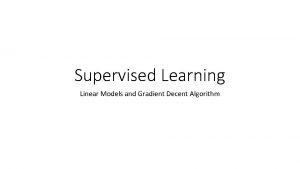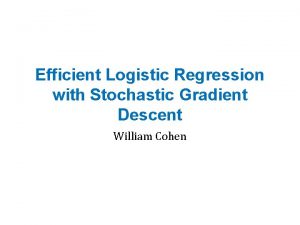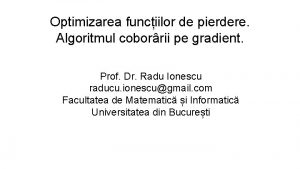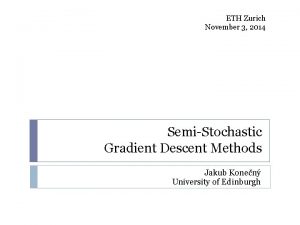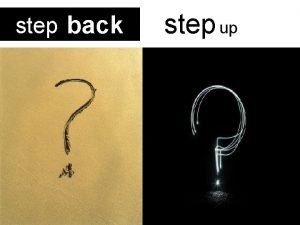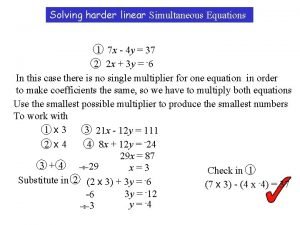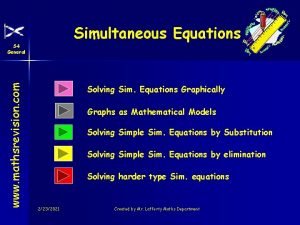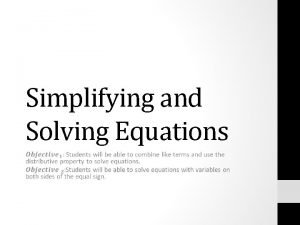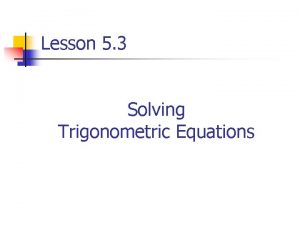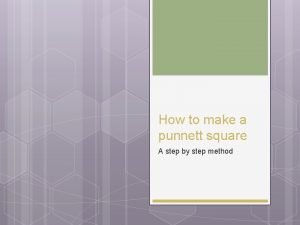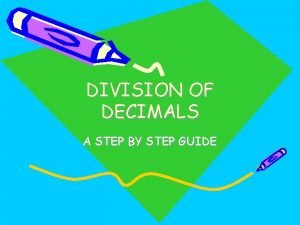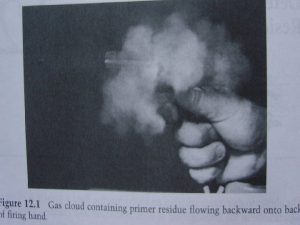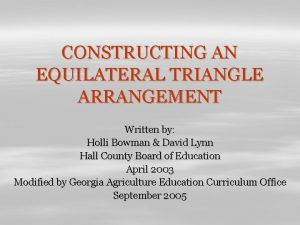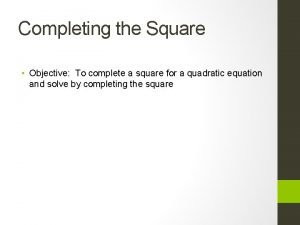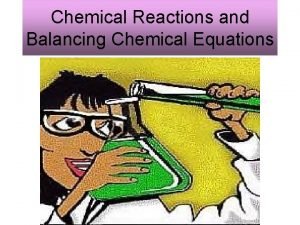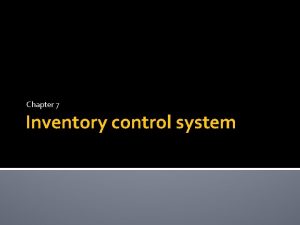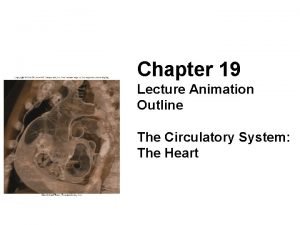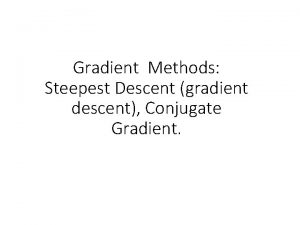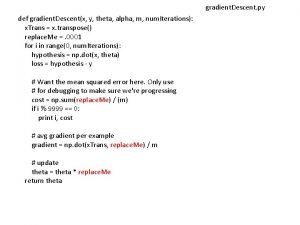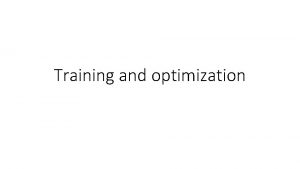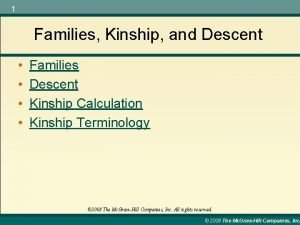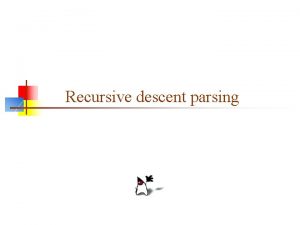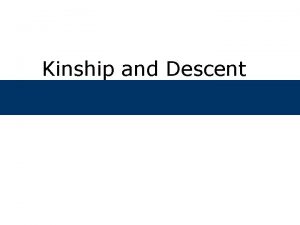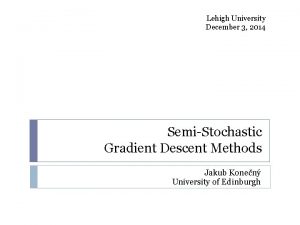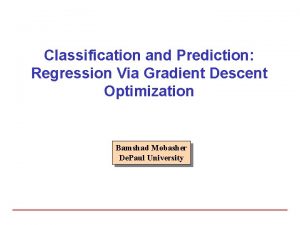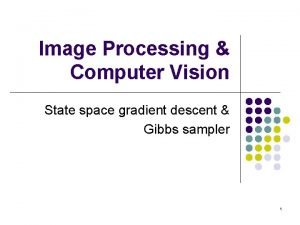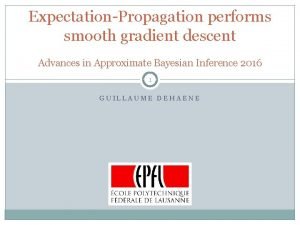Gradient Descent Review Gradient Descent In step 3






































- Slides: 38

Gradient Descent

Review: Gradient Descent • In step 3, we have to solve the following optimization problem: L: loss function Suppose that θ has two variables {θ 1, θ 2}

Review: Gradient Descent Gradient: Loss 的等高線的法線方向 Gradient Movement ……

Gradient Descent Tip 1: Tuning your learning rates

Learning Rate If there are more than three parameters, you cannot visualize this. Set the learning rate η carefully Loss Very Large small Large Loss Just make No. of parameters updates But you can always visualize this.

Adaptive Learning Rates •

Adagrad • Divide the learning rate of each parameter by the root mean square of its previous derivatives Vanilla Gradient descent w is one parameters Adagrad Parameter dependent

Adagrad

Adagrad • Divide the learning rate of each parameter by the root mean square of its previous derivatives 1/t decay

Contradiction? Vanilla Gradient descent Adagrad Larger gradient, larger step Larger gradient, smaller step

Intuitive Reason • How surprise it is 反差 特別大 g 0 g 1 g 2 g 3 g 4 0. 001 0. 003 0. 002 0. 1 …… …… g 0 10. 8 …… …… g 1 20. 9 g 2 31. 7 g 3 12. 1 g 4 0. 1 特別小 造成反差的效果

Larger gradient, larger steps? Larger 1 st order derivative means far from the minima Best step:

Larger 1 st order derivative means far from the minima Do not cross parameters Comparison between different parameters a a>b b c c>d d

Second Derivative Best step: The best step is |First derivative| Second derivative

Larger 1 st order derivative means far from the minima Do not cross parameters Comparison between different parameters The best step is Larger Second |First derivative| Second derivative a a>b b smaller second derivative c Smaller Second c>d d Larger second derivative

The best step is |First derivative| ? Second derivative Use first derivative to estimate second derivative smaller second derivative larger second derivative

Gradient Descent Tip 2: Stochastic Gradient Descent Make the training faster

Stochastic Gradient Descent Loss is the summation over all training examples u. Gradient Descent u. Stochastic Gradient Descent Pick an example xn Loss for only one example Faster!

• Demo

Stochastic Gradient Descent Update after seeing all examples See all examples Update for each example If there are 20 examples, 20 times faster. See only one example See all examples

Gradient Descent Tip 3: Feature Scaling

Feature Scaling Source of figure: http: //cs 231 n. github. io/neuralnetworks-2/ Make different features have the same scaling

Feature Scaling 1, 2 …… 100, 200 …… 1, 2 …… Loss L

Feature Scaling For each dimension i: …… …… The means of all dimensions are 0, and the variances are all 1

Gradient Descent Theory

Question • by gradient descent Is this statement correct?

Warning of Math

Formal Derivation • Suppose that θ has two variables {θ 1, θ 2} Given a point, we can easily find the point with the smallest value nearby. How? L(θ)

Taylor Series • Taylor series: Let h(x) be any function infinitely differentiable around x = x 0. When x is close to x 0

E. g. Taylor series for h(x)=sin(x) around x 0=π/4 sin(x)= …… The approximation is good around π/4.

Multivariable Taylor Series + something related to (x-x 0)2 and (y-y 0)2 + …… When x and y is close to x 0 and y 0

Back to Formal Derivation Based on Taylor Series: If the red circle is small enough, in the red circle L(θ)

Back to Formal Derivation constant Based on Taylor Series: If the red circle is small enough, in the red circle Find θ 1 and θ 2 in the red circle minimizing L(θ) Simple, right? d

Gradient descent – two variables Red Circle: (If the radius is small) Find θ 1 and θ 2 in the red circle minimizing L(θ) To minimize L(θ)

Back to Formal Derivation Based on Taylor Series: If the red circle is small enough, in the red circle constant This is gradient descent. Not satisfied if the red circle (learning rate) is not small enough You can consider the second order term, e. g. Newton’s method.

End of Warning

More Limitation of Gradient Descent Loss Very slow at the plateau Stuck at saddle point Stuck at local minima The value of the parameter w

 Step 1 step 2 step 3 step 4
Step 1 step 2 step 3 step 4 Gradient descent equation
Gradient descent equation Gradient descent multiple variables
Gradient descent multiple variables Logistic regression stochastic gradient descent
Logistic regression stochastic gradient descent Linear regression gradient descent
Linear regression gradient descent Batch gradient descent
Batch gradient descent Stochastic gradient descent
Stochastic gradient descent Kay ousterhout
Kay ousterhout Gradient descent python implementation
Gradient descent python implementation Gradient descent rule
Gradient descent rule Buccal pit molar
Buccal pit molar The age of the dinosaurs text structure
The age of the dinosaurs text structure Steps to write an informative essay
Steps to write an informative essay Steps of argumentative essay
Steps of argumentative essay Step back step up
Step back step up How to factor equations
How to factor equations Linear simultaneous equations
Linear simultaneous equations Simultaneous equations step by step
Simultaneous equations step by step Combine like terms steps
Combine like terms steps The process of photosynthesis step by step
The process of photosynthesis step by step Particle filter matlab code
Particle filter matlab code Oracle real application testing step by step
Oracle real application testing step by step Netbackup bare metal restore step by step
Netbackup bare metal restore step by step 5-3 solving trigonometric equations
5-3 solving trigonometric equations Naomi campbell face shape
Naomi campbell face shape Step by step how to set up a punnett square
Step by step how to set up a punnett square Viva video collage
Viva video collage Fusioncompute installation step by step
Fusioncompute installation step by step Sine rule graph
Sine rule graph How to divide decimals step by step
How to divide decimals step by step Negative and positive result of paraffin test
Negative and positive result of paraffin test Isosceles triangle arrangement
Isosceles triangle arrangement Completing the square
Completing the square Completing the square conic sections
Completing the square conic sections Chemical equation examples
Chemical equation examples Step-by step inventory process
Step-by step inventory process How to balance chemical equations step by step
How to balance chemical equations step by step Blood flow through the heart step by step
Blood flow through the heart step by step Chapter 15 musculoskeletal system practical
Chapter 15 musculoskeletal system practical

